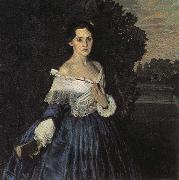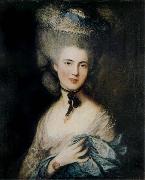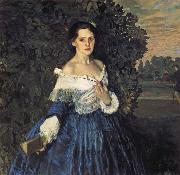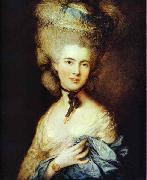
|
Konstantin Somov
|
|||
|
|
|||
| Russian Symbolist Painter, 1869-1939 Russian painter and graphic artist. He was the son of a curator at the Hermitage, and he attended the St Petersburg Academy of Art from 1888 to 1897, studying under the Realist painter Il'ya Repin from 1894. In 1897 and again in 1898-9 he went to Paris and attended the studios of Filippo Colarossi and of Whistler. Neither the Realism of his Russian teachers nor the evanescent quality of Whistler's art was reflected for long in Somov's work. He turned instead for inspiration to the Old Masters in the Hermitage and to works of contemporary English and German artists | |||
|
|
|||
|
Lady in Blue new4/Konstantin Somov-955584.jpg Painting ID:: 31224 |
mk72 1897-1900 | ||
|
|
|||
|
Thomas Gainsborough
|
|||
|
|
|||
| 1727-1788 British Thomas Gainsborough Locations English painter, draughtsman and printmaker. He was the contemporary and rival of Joshua Reynolds, who honoured him on 10 December 1788 with a valedictory Discourse (pubd London, 1789), in which he stated: If ever this nation should produce genius sufficient to acquire to us the honourable distinction of an English School, the name of Gainsborough will be transmitted to posterity, in the history of Art, among the very first of that rising name. He went on to consider Gainsborough portraits, landscapes and fancy pictures within the Old Master tradition, against which, in his view, modern painting had always to match itself. Reynolds was acknowledging a general opinion that Gainsborough was one of the most significant painters of their generation. Less ambitious than Reynolds in his portraits, he nevertheless painted with elegance and virtuosity. He founded his landscape manner largely on the study of northern European artists and developed a very beautiful and often poignant imagery of the British countryside. By the mid-1760s he was making formal allusions to a wide range of previous art, from Rubens and Watteau to, eventually, Claude and Titian. He was as various in his drawings and was among the first to take up the new printmaking techniques of aquatint and soft-ground etching. Because his friend, the musician and painter William Jackson (1730-1803), claimed that Gainsborough detested reading, there has been a tendency to deny him any literacy. He was, nevertheless, as his surviving letters show, verbally adept, extremely witty and highly cultured. He loved music and performed well. He was a person of rapidly changing moods, humorous, brilliant and witty. At the time of his death he was expanding the range of his art, having lived through one of the more complex and creative phases in the history of British painting. He painted with unmatched skill and bravura; while giving the impression of a kind of holy innocence, he was among the most artistically learned and sophisticated painters of his generation. It has been usual to consider his career in terms of the rivalry with Reynolds that was acknowledged by their contemporaries; while Reynolds maintained an intellectual and academic ideal of art, Gainsborough grounded his imagery on contemporary life, maintaining an aesthetic outlook previously given its most powerful expression by William Hogarth. His portraits, landscapes and subject pictures are only now coming to be studied in all their complexity; having previously been viewed as being isolated from the social, philosophical and ideological currents of their time, they have yet to be fully related to them. It is clear, however, that his landscapes and rural pieces, and some of his portraits, were as significant as Reynolds acknowledged them to be in 1788. | |||
|
|
|||
|
Lady in Blue new16/Thomas Gainsborough-267927.jpg Painting ID:: 41062 |
mk159 1770s Oil on canvas 76x64cm | ||
|
|
|||
|
Konstantin Somov
|
|||
|
|
|||
| Russian Symbolist Painter, 1869-1939 Russian painter and graphic artist. He was the son of a curator at the Hermitage, and he attended the St Petersburg Academy of Art from 1888 to 1897, studying under the Realist painter Il'ya Repin from 1894. In 1897 and again in 1898-9 he went to Paris and attended the studios of Filippo Colarossi and of Whistler. Neither the Realism of his Russian teachers nor the evanescent quality of Whistler's art was reflected for long in Somov's work. He turned instead for inspiration to the Old Masters in the Hermitage and to works of contemporary English and German artists | |||
|
|
|||
|
Lady in Blue new18/Konstantin Somov-299829.jpg Painting ID:: 49111 |
mk193 1897-1900 Oil on canvas 103x103cm | ||
|
|
|||
|
Thomas Gainsborough
|
|||
|
|
|||
| 1727-1788 British Thomas Gainsborough Locations English painter, draughtsman and printmaker. He was the contemporary and rival of Joshua Reynolds, who honoured him on 10 December 1788 with a valedictory Discourse (pubd London, 1789), in which he stated: If ever this nation should produce genius sufficient to acquire to us the honourable distinction of an English School, the name of Gainsborough will be transmitted to posterity, in the history of Art, among the very first of that rising name. He went on to consider Gainsborough portraits, landscapes and fancy pictures within the Old Master tradition, against which, in his view, modern painting had always to match itself. Reynolds was acknowledging a general opinion that Gainsborough was one of the most significant painters of their generation. Less ambitious than Reynolds in his portraits, he nevertheless painted with elegance and virtuosity. He founded his landscape manner largely on the study of northern European artists and developed a very beautiful and often poignant imagery of the British countryside. By the mid-1760s he was making formal allusions to a wide range of previous art, from Rubens and Watteau to, eventually, Claude and Titian. He was as various in his drawings and was among the first to take up the new printmaking techniques of aquatint and soft-ground etching. Because his friend, the musician and painter William Jackson (1730-1803), claimed that Gainsborough detested reading, there has been a tendency to deny him any literacy. He was, nevertheless, as his surviving letters show, verbally adept, extremely witty and highly cultured. He loved music and performed well. He was a person of rapidly changing moods, humorous, brilliant and witty. At the time of his death he was expanding the range of his art, having lived through one of the more complex and creative phases in the history of British painting. He painted with unmatched skill and bravura; while giving the impression of a kind of holy innocence, he was among the most artistically learned and sophisticated painters of his generation. It has been usual to consider his career in terms of the rivalry with Reynolds that was acknowledged by their contemporaries; while Reynolds maintained an intellectual and academic ideal of art, Gainsborough grounded his imagery on contemporary life, maintaining an aesthetic outlook previously given its most powerful expression by William Hogarth. His portraits, landscapes and subject pictures are only now coming to be studied in all their complexity; having previously been viewed as being isolated from the social, philosophical and ideological currents of their time, they have yet to be fully related to them. It is clear, however, that his landscapes and rural pieces, and some of his portraits, were as significant as Reynolds acknowledged them to be in 1788. | |||
|
|
|||
|
Lady in Blue new20/Thomas Gainsborough-255583.jpg Painting ID:: 58909 |
Lady in Blue (c. 1770) | ||
|
|
|||
|
Also Buy::. For Following Paintings / Artists / Products, Please Use Our Search Online: |











